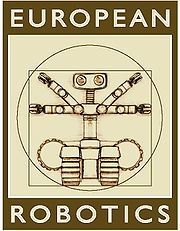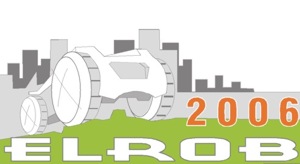
European Land-Robot Trial
Encyclopedia

The ELROB is not a competition, like the US DARPA Grand Challenge
DARPA Grand Challenge
The DARPA Grand Challenge is a prize competition for driverless vehicles, funded by the Defense Advanced Research Projects Agency, the most prominent research organization of the United States Department of Defense...
, but a pure demonstration of what European robotics
Robotics
Robotics is the branch of technology that deals with the design, construction, operation, structural disposition, manufacture and application of robots...
is able to achieve today. The scenarios are designed to simulate real world missions, be it military or civilian ones. There are no artificial constraints set to this scenarios to ease the task for the robots like e.g. very visible road markings. This forces the participating teams and systems to fulfil high requirements set by the real world scenarios.
The first ELROB in 2006 was organized by the German Federal Armed Forces
Bundeswehr
The Bundeswehr consists of the unified armed forces of Germany and their civil administration and procurement authorities...
and took place on the infantry training area
Proving ground
A proving ground is the US name for a military installation or reservation where weapons or other military technology are experimented or tested, or where military tactics are tested...
near Hammelburg
Hammelburg
Hammelburg is a town in the district of Bad Kissingen, in Lower Franconia, Bavaria, Germany. It is situated on the river Franconian Saale, 25 km west of Schweinfurt...
, 15-18 May 2006. The goal of the first trial was to boost the development of unmanned ground vehicle
Unmanned ground vehicle
An unmanned ground vehicle is a military robot used to augment the soldiers capability. This type of robot is generally capable of operating outdoors and over a wide variety of terrain, functioning in place of humans....
s that could be used in military missions on short notice. The ELROB is an annual event and alternates between a military and a civilian focus each year.
European Robotics and the NATO Research Task Group "Military Applications for Multi-Robot Systems" came up with the idea for ELROB in the year 2004. European Robotics aims to bridge the gap between defence and security (D&S) users, industry and research in the field of ground robotics. The ELROB is a good opportunity to follow these goals.
Because ELROB is meant to be a European trial, only teams from Europe are allowed. But both teams of commercial and academic backgrounds are allowed.
Civilian ELROB
The civilian ELROB (short C-ELROB) takes place every two years alternating with the military version. It was initiated to allow teams, which are not interested in military missions or cooperation, to attend ELROB, too. Sadly, until today, there is no team that takes part only on the C-ELROB. On the other hand, of course, the defence companies are not that interested in the civilian ELROB. Therefore, the number of teams on C-ELROB is a bit lower than on M-ELROB and organisation is a bit less strict. Most teams do not see C-ELROB as competition or as demonstration, but as possibility to prove their own systems in a challenging field test and new surroundings. It is a great opportunity to learn new things about their robot systems and find new approaches.ELROB is explicitly designed to shape the direction of R&D for the short and medium term and aims to fertilize the co-operation between research and SMEs.
Scenarios
In general the scenarios should be mastered with maximum autonomy, although teleoperation is allowed. The location for the scenario is kept secret until short before the start of the trials and therefore the teams have no chance to generate a detailed map of the area (for example with laser range finders) ahead of their run. The location is described to the participants by GPS coordinates and aerial imagery.Reconnaissance and Surveillance
The task in the "Reconnaissance and Surveillance" setting is to reach a given area and explore it. During the exploration special points of interest (normally marked) need to be detected and localized. The position of this points and a photograph should be given to the judges as results of the run. If possible, the robot should return to its starting position, when it finished exploring.Autonomous Navigation
The aim of the "Autonomous Navigation" scenario is to follow a given route mostly autonomous. The route will be some kilometers in length. During the traversal of the route points of interest (usually marked) need to be found and localised. Again the position and a photograph of the points of interest need to be given to the judges as results of the run.Camp Security
The "Camp Security" scenario requires the robots to guard a predefined area for the time of the scenario run. During the run (marked) intruders will be entering the area and need to be detected, tracked and pursued. An image of the intruder and its location while it was captured need to be given to the judges as result. Capturing means "drive near the intruder and stop", then the captured intruder will leave the area.Transport Mule
The "Transport Mule" scenario simulates a shuttle service. The robot should install a shuttle service between two given points as autonomously as possible and shuttle between those points as often as possible during the time of its scenario run.2007

Ticino
Canton Ticino or Ticino is the southernmost canton of Switzerland. Named after the Ticino river, it is the only canton in which Italian is the sole official language...
), 13-16 August. The area of the trials was part of the truck test track of the Swiss army which meant very difficult ground for the vehicles.
With this ELROB the scenario "Autonomous Navigation" was integrated into ELROB for the first time. It was created on public demand to allow bigger vehicles to better show their abilities. Therefore the track length of "Autonomous Navigation" was several kilometres. Additionally, there were three versions of the "Reconnaissance and Surveillance" setting. The first was in urban area which included intrusion of buildings. The second was placed in non urban area with higher requirements on the off-road mobility of the vehicles and the third one concentrated on the combination of UGVs and UAVs
Unmanned aerial vehicle
An unmanned aerial vehicle , also known as a unmanned aircraft system , remotely piloted aircraft or unmanned aircraft, is a machine which functions either by the remote control of a navigator or pilot or autonomously, that is, as a self-directing entity...
. All scenario run times were limited to 45 minutes.
The result of C-ELROB 2007 was, that there are some semi-autonomous assistance functions ready. Most vehicles managed to drive in difficult outdoor terrain, too. But some of the teams were surprised by reality and had severe problems with radio communication and battery power.
There were 14 participating teams in total. Nine of the teams came from Germany, two from Poland and one from Finland, Swiss and Portugal, respectively.
2009

Oulu
Oulu is a city and municipality of inhabitants in the region of Northern Ostrobothnia, in Finland. It is the most populous city in Northern Finland and the sixth most populous city in the country. It is one of the northernmost larger cities in the world....
, Finland
Finland
Finland , officially the Republic of Finland, is a Nordic country situated in the Fennoscandian region of Northern Europe. It is bordered by Sweden in the west, Norway in the north and Russia in the east, while Estonia lies to its south across the Gulf of Finland.Around 5.4 million people reside...
, 15-17 June. The area of the trials was a former zoo and a part of a public forest near the University of Oulu
University of Oulu
The University of Oulu is one of the largest universities in Finland, located in the city of Oulu. It was founded on July 8, 1958. The university has around 16,000 students and 3,000 staff...
.
The scenarios were very similar to the ones on the military ELROB 2008. This was due to public demand of the participants who requested more continuity in the scenarios to have the chance to catch up with the requirements of a scenario and not be confronted with different scenarios and requirements each year. Therefore there were the "Reconnaissance and Surveillance", "Autonomous Navigation", "Camp Security" and "Transport Mule" scenarios. Additionally, all points of interest and the intruders in the "Camp Security" scenario were marked with ERICards, because computer vision
Computer vision
Computer vision is a field that includes methods for acquiring, processing, analysing, and understanding images and, in general, high-dimensional data from the real world in order to produce numerical or symbolic information, e.g., in the forms of decisions...
was no focus of the trials. The run time of the scenarios was limited to 60 minutes.
ELROB 2009 was attended by ten teams. Seven teams came from Germany and one from France, Poland and Finland, each.
Military ELROB
The military ELROB (short M-ELROB) has a sharp focus on short-term realisable systems which are able to fulfil the requirements of common military tasks. Therefore the scenarios simulate real world missions as close as possible which is reflected by the fact that members of the BundeswehrBundeswehr
The Bundeswehr consists of the unified armed forces of Germany and their civil administration and procurement authorities...
are part of the organisation committee. The organisers do not place artificial constraints on the scenarios regardless of the abilities of the robots. One example was the very bad radio communication encountered during M-ELROB 2008, because most trials took place in the forest. M-ELROB is explicitly designed to assess current technology to solve real world problems at hand.
M-ELROB is a tool to bring together users, researchers and industry.
Scenarios
The scenarios of the M-ELROBs correspond to real military situations like Reconnaissance and Surveillance missions. In general the scenarios should be mastered with maximum autonomy, although teleoperation is allowed. The location for the scenario is kept secret until short before the start of the trials and therefore the teams have no chance to generate a detailed map of the area (for example with laser range finders) ahead of their run. The location is described to the participants by GPS coordinates and aerial imagery.Reconnaissance and Surveillance
The task in the "Reconnaissance and Surveillance" setting is to reach a given area and explore it. During the exploration special points of interest (normally marked) need to be detected and localized. The position of this points and a photograph should be given to the judges as results of the run. If possible, the robot should return to its starting position, when it finished exploring.Autonomous Navigation
The aim of the "Autonomous Navigation" scenario is to follow a given route mostly autonomous. The route will be some kilometers in length. During the traversal of the route points of interest (usually marked) need to be found and localised. Again the position and a photograph of the points of interest need to be given to the judges as results of the run.Camp Security
The "Camp Security" scenario requires the robots to guard a predefined area for the time of the scenario run. During the run (marked) intruders will be entering the area and need to be detected, tracked and pursued. An image of the intruder and its location while it was captured need to be given to the judges as result. Capturing means "drive near the intruder and stop", then the captured intruder will leave the area.Transport Convoy
The "Transport Convoy" mission requests at least two vehicles to be navigated, as fast as possible, to a target position which is several kilometres away. A payload of about 50 kg needs to be transported. At most one of the vehicles may be controlled by human, which may reduce the task for the robot to autonomously follow a vehicle. Of course two (or more) completely autonomously vehicles are better.Transport Mule
The "Transport Mule" scenario simulates a shuttle service. The robot should install a shuttle service between two given points as autonomously as possible and shuttle between those points as often as possible during the time of its scenario run.2006

M-ELROB 2006 was the first ELROB and was utilized to paint a picture of the possibilities of modern robotics. The scenarios were concentrated on navigation. One was located in urban terrain which includes intrusion into buildings. The other scenario took place outdoors on a more challenging ground with mud and very steep slopes. Both scenarios fall into the category "Reconnaissance and Surveillance", although there were no points of interest that needed to be found. The time limit was 30 minutes.
The result of M-ELROB 2006 was disillusioning. Most of the teams had to fight hardware failures and all were remote controlled via WLAN. All in all 18 teams were participating, eleven German teams, three from the UK, two from Swiss and one from Portugal and France, each.
2008

The scenarios were much more manifold than in 2006 and 2007. There were "Reconnaissance and Surveillance", "Autonomous Navigation", "Transport Convoy", "Transport Mule" and "Camp Security". This scenarios required very diverse abilities from the robot systems. Additionally one special session of the "Reconnaissance and Surveillance" scenario took place at night time, so vision systems were unusable. The run time limit was 60 minutes for a scenario run.
The results of ELROB 2008 showed that remote controlled UGVs are more or less ready for deployment, but the radio communication places severe constraints on the usability of such systems. With semi autonomous assistance functions, like e.g. waypoint navigation, the robot system is much more useful while encountering bad radio communication.
M-ELROB 2008 was attended by 17 teams. Eleven from Germany, two from the UK and one from Italy, the Netherlands, France and Finland, respectively.
2010
The military ELROB 2010 took place from June 17 to 20 2010 on the army training area near HammelburgHammelburg
Hammelburg is a town in the district of Bad Kissingen, in Lower Franconia, Bavaria, Germany. It is situated on the river Franconian Saale, 25 km west of Schweinfurt...
in Germany
Germany
Germany , officially the Federal Republic of Germany , is a federal parliamentary republic in Europe. The country consists of 16 states while the capital and largest city is Berlin. Germany covers an area of 357,021 km2 and has a largely temperate seasonal climate...
.
2012
The military ELROB 2012 will take place from September 24 to 28 2012 on the training area of the Swiss Army near ThunThun
Thun is a municipality in the administrative district of Thun in the canton of Bern in Switzerland with about 42,136 inhabitants , as of 1 January 2006....
in Switzerland
Switzerland
Switzerland name of one of the Swiss cantons. ; ; ; or ), in its full name the Swiss Confederation , is a federal republic consisting of 26 cantons, with Bern as the seat of the federal authorities. The country is situated in Western Europe,Or Central Europe depending on the definition....
.
See also
- Multi Autonomous Ground-robotic International ChallengeMulti Autonomous Ground-robotic International ChallengeThe Multi Autonomous Ground-robotic International Challenge is a 1.6 million dollar prize competition for autonomous mobile robots funded by TARDEC and the DSTO the primary research organizations for Tank and Defense research in the United States and Australia respectively...
- DARPA Grand ChallengeDARPA Grand ChallengeThe DARPA Grand Challenge is a prize competition for driverless vehicles, funded by the Defense Advanced Research Projects Agency, the most prominent research organization of the United States Department of Defense...
- NATO

